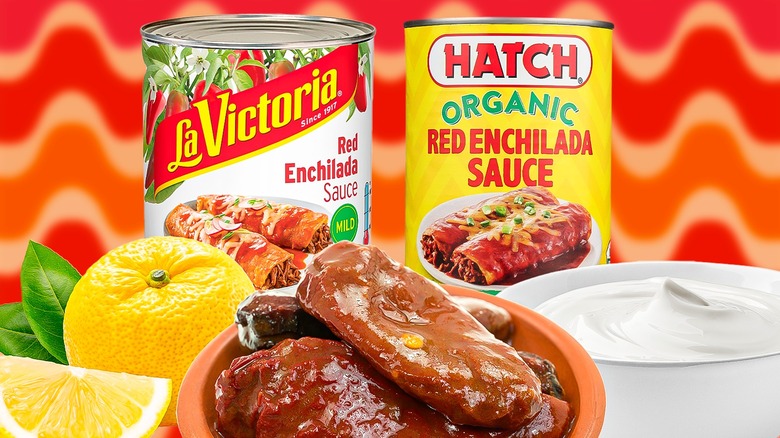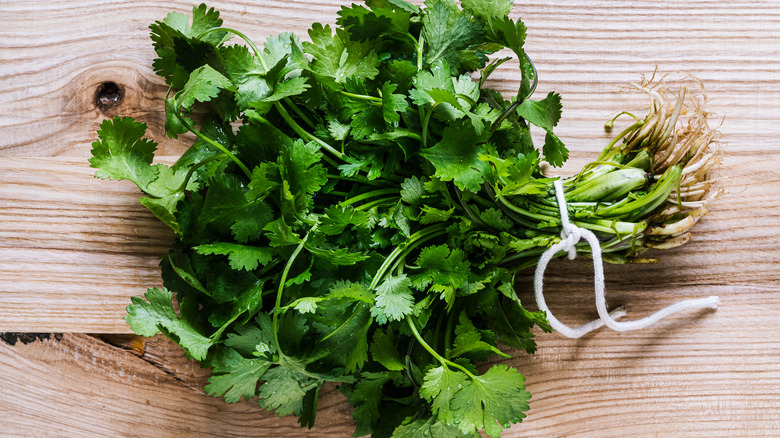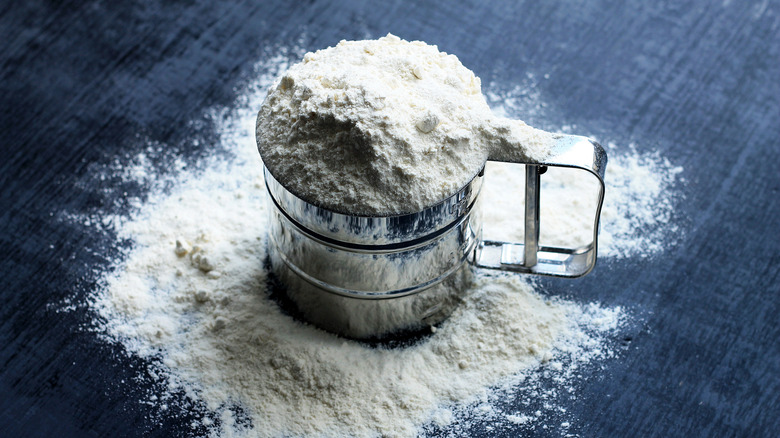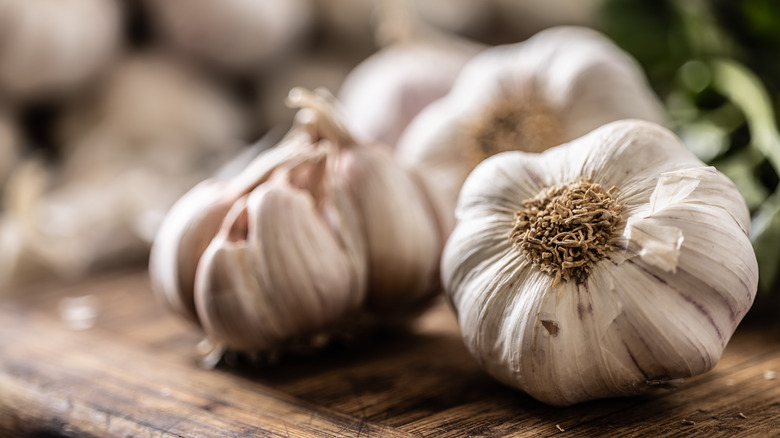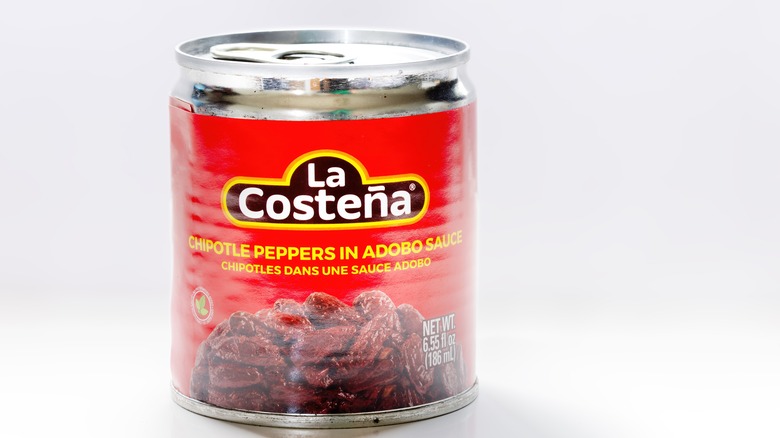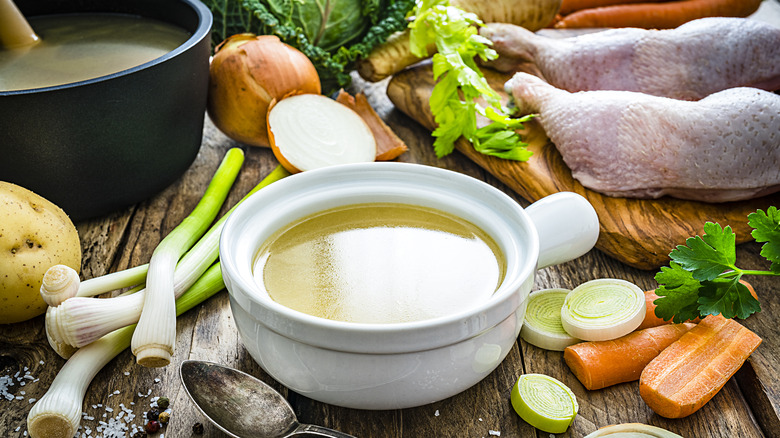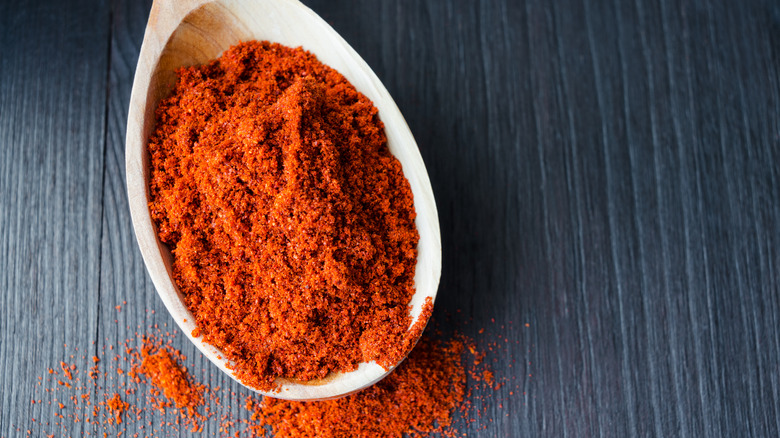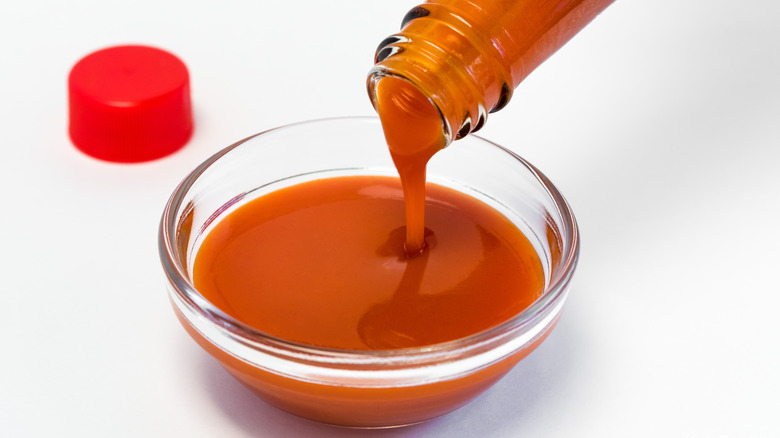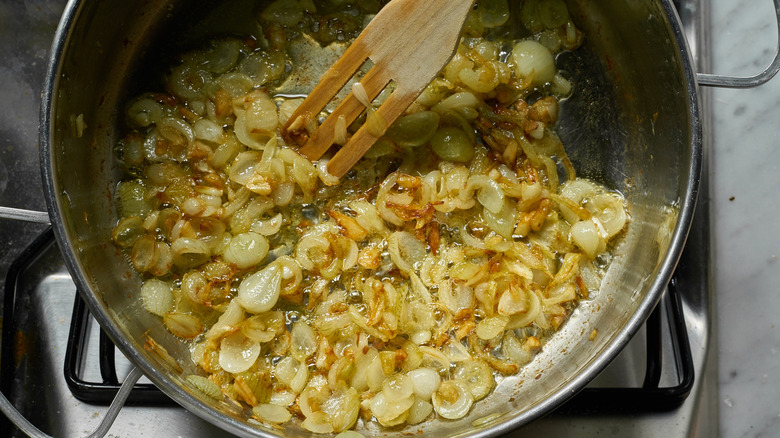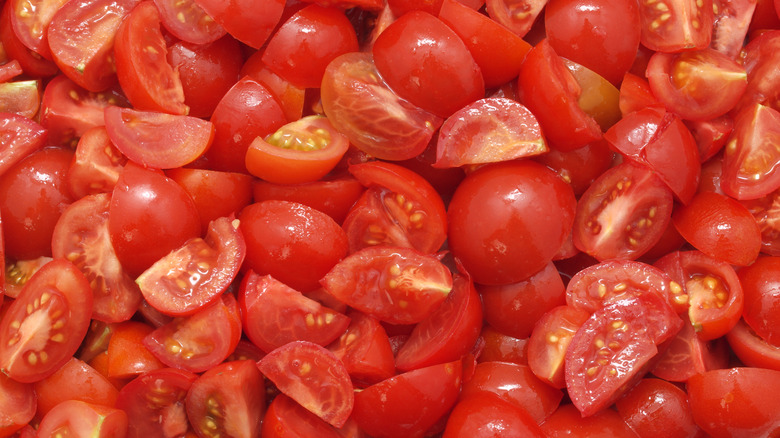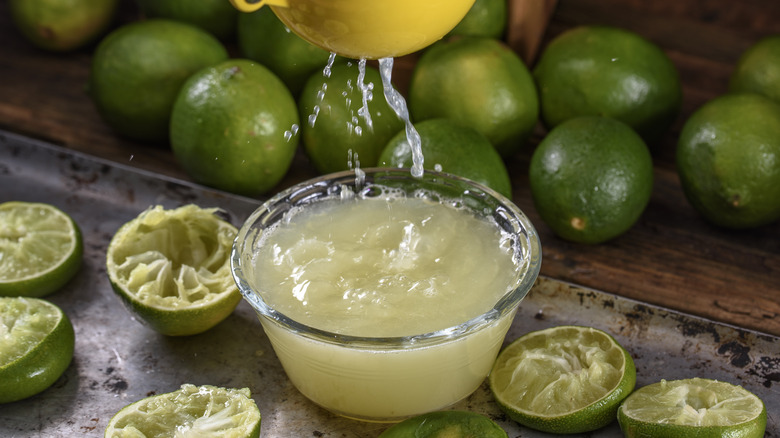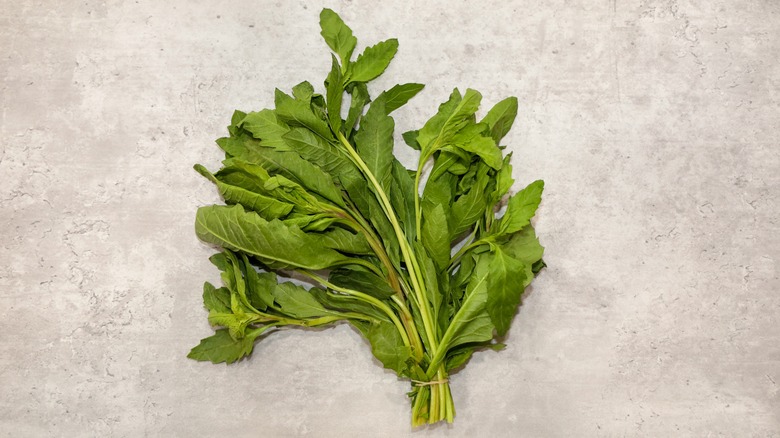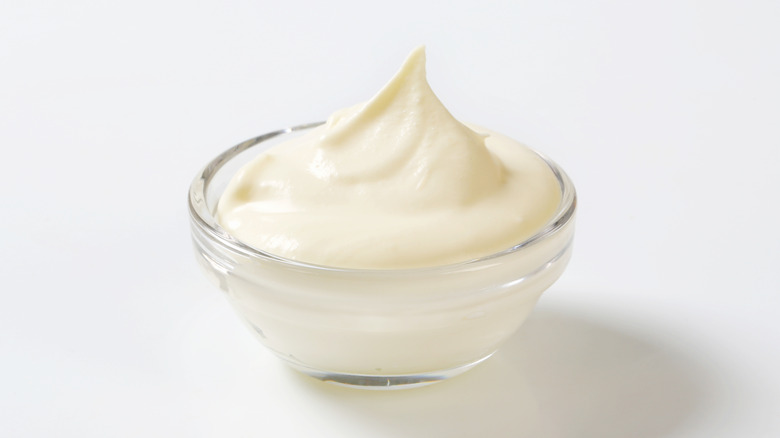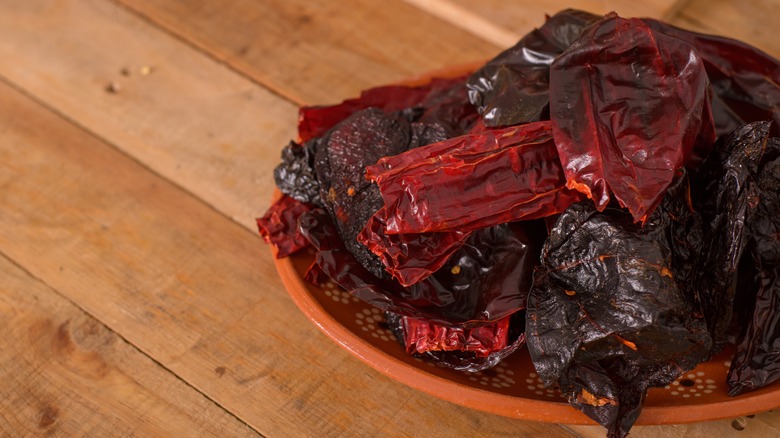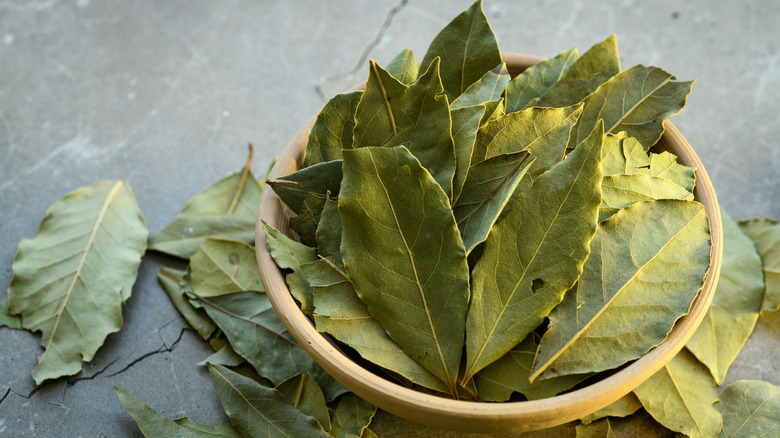15 Absolute Best Add-Ins For Canned Enchilada Sauce
Enhancing canned enchilada sauce can be as simple or complex as you'd like. It helps that there are plenty of additions to upgrade enchiladas, whether you want to toast the spices to give them a fragrant intensity, or grill vegetables for a deeper flavor. Make enchiladas vegan with loads of veggies, add cheese for a vegetarian version, or use meats like chicken, turkey, or beef.
When you're trying to get dinner on the table, canned enchilada sauce makes a great option if you're unable to make it from scratch. There are many easy methods to bolster its flavor so that it mimics a homemade sauce. To help us come up with ideas on how to do so, we consulted with a couple of skilled cooks.
Jessica Randhawa is a recipe creator and the head chef behind The Forked Spoon, where she focuses on family-friendly recipes such as enchiladas. Ranveer Brar is a "MasterChef India" judge and owner of Kashkan Restaurants, offering richly spiced experiences of Indian cuisine and culture. These experts provided their tips on the absolute best add-ins for canned enchilada sauce, so that you can make it as flavorful as possible. You'll find many of these ingredients available in cans, but fresh versions amplify the taste. However, all of these add-ins bring something new to the table in terms of flavor, aroma, balance, or texture. Pick your enchilada recipe and grab some canned green or red sauce, because you're going to want to try these out.
Fresh cilantro
Both of our experts recommend fresh cilantro, so this easily accessible herb is one of the top choices for upgrading canned enchilada sauce. Fresh cilantro gives the sauce a burst of flavor and an aroma that the dried herb can't offer.
To impart freshness to canned enchilada sauce, "fresh coriander is my favorite ingredient to add," says Ranveer Brar. "It helps improve the taste of the dish by tossing in this bright, citrusy accent, which brings to balance the richness of a sauce." Brar explains that the herb not only enriches the flavor of the sauce, but also brings a bright green component to your meal.
Chop some sprigs of cilantro and stir them into the sauce right before serving. This gives it time to warm while also retaining its green hue. Jessica Randhawa agrees that the herb should be added at the last minute for a colorful, inviting meal. "This works especially well if you find the canned sauce a bit flat, or overly sweet," says Randhawa. "Cilantro brightens the dish and brings a lovely balance to the richer flavors of the enchiladas." Additionally, cilantro can help take the edge off of spicy food.
Flour and sugar
This might seem like a funky combination for a savory dish, but flour and sugar are all you need to fix bitter canned enchilada sauce. Start by opening and heating up the sauce in a pan and then whisking in the flour and sugar.
These pantry staples balance the bitterness, and the flour acts as a thickener, which is useful if your sauce is on the runny side. Slowly whisk these ingredients in and taste, and then decide if the sauce needs more. It can quickly turn into a sweet, congealed mess if you pour it with a heavy hand. There's no exact measurement to recommend, since the amounts can vary based on how many cans of sauce you're using, and what brand.
Simmer everything on the stove for 15 minutes to ensure that the sugar fully dissolves, and the flour clumps disperse. The flavors won't overshadow the sauce, and instead enhance the taste. This multipurpose add-in can turn a bland sauce into a better one — and it's practical since you likely already have flour and sugar in your cabinet.
Garlic
Garlic is a welcome addition for many dishes, because it's so adaptable based on how you use it. Just a bit of garlic powder will give canned enchilada sauce extra flavor.
We wouldn't recommend adding uncooked garlic directly into the sauce, since that can make it potent and bitter. Sauté or roast fresh garlic before incorporating it for deeper flavor. Ranveer Brar explains that adding roasted garlic to canned enchilada sauce "introduces sweet and savory elements." The acid and depth mellow out, while the umami flavor comes to life with this epicurean hack.
Make a simple oven-roasted garlic recipe to add this ingredient to your enchilada sauce. While it takes 45 minutes to roast garlic, the process is not labor-intensive, so you can pop it in the oven and relax. Brar recommends gently smooshing a few roasted cloves to create a paste before mixing it into the simmering sauce. "Subsequently, these cooking tactics make homemade style rather complex," says Brar. Garlic brings both aroma and flavor to make red and green canned enchilada sauce delicious.
Chipotle peppers in adobo sauce
"One of my go-to add-ins for canned enchilada sauce is chipotle peppers in adobo sauce," says Jessica Randhawa. "The smoky flavor of the chipotle peppers adds a deep, rich layer to the sauce, while the adobo brings a tangy kick."
Rather than pour the peppers directly into the sauce, take an extra step to make the end result less lumpy. "I typically blend one or two peppers along with a spoonful of the adobo sauce into the enchilada sauce for a smooth consistency," Randhawa explains. This way, you won't accidentally eat an entire pepper in one bite, and the texture of the enchilada sauce is seamlessly integrated.
That said, chipotle peppers work best visually with red sauce, as the mix of red peppers and green sauce might create a funky color. Canned chipotle peppers are often packaged with onion, vinegar, tomato paste, and spices, making this a convenient addition to enhance the taste of your meal. "This is perfect if you're looking to elevate the sauce with a robust and smoky flavor that complements chicken or beef enchiladas wonderfully," says Randhawa.
Broth or stock
Use broth, stock, or bouillon to give enchilada sauce flavor in a jiffy. These tend to have savory ingredients, such as onion powder, sea salt, garlic powder, olive oil, or turmeric. You can make it from scratch, but if we're opting for canned enchilada sauce, using premade stock is an effective, quick way to give it flavor. This tip also provides the ability to sway the overall consistency of the sauce — and if you find it ends up being too watery, add a pinch of flour to help thicken it up.
When possible, match the stock with your added protein for the best flavor — such as chicken stock for enchiladas with poultry like chicken or turkey, or beef stock with ground beef. But, you can mix and match with what you have on hand. We've certainly used beef bouillon with chicken-based meals, and it didn't ruin the overall flavor of the dish. Use this add-in for green or red enchilada sauce, and give the mixture time to simmer to reduce the liquid.
Smoked paprika
If you're deciding between adding regular or smoked paprika to canned enchilada sauce, go for the smoked variety. You can undoubtedly opt for either, but the smoked version brings a bolder, spicier character that will be more pronounced in your dish.
"The use of smoked paprika in canned enchilada sauce will give your dish an understated smoky flavor that complements traditional spices," says Ranveer Brar. "Besides that, it will also lend a nice reddish color."
Since it brings an earthy quality, smoked paprika somewhat mimics the depth that roasted peppers or vegetables would bring when making enchilada sauce from scratch. Brar says that stirring in a single teaspoon of this spice will make a significant difference. "This small touch makes it seem like the sauces have been simmered for hours," he shares. Liquid smoke is another similar way to bypass the grilling or roasting process to bring in a smoky punch.
Hot sauce
You probably have a bottle of hot sauce in your pantry, or at least a few packets of it from a fast-food restaurant. Bring those out and incorporate them into your enchilada sauce. Hot sauce quickly provides a flavorful boost, with the ability to add as much or as little as you desire. Use mild hot sauce when you want a light touch of spice, or go fiery with extremely spicy hot sauce. The choice depends on how much heat you like for your enchiladas.
There are numerous flavors to choose from, too, with hot sauce brands featuring everything from green chilies to mango. For best results, use a flavor that pairs well with the ingredients in your canned enchilada sauce, like garlic or onion. A smoky hot sauce can have a satisfying taste, but banana hot sauce might not be a good choice for this; you don't want to venture too far out there.
Mix a few dashes of your desired hot sauce into the enchilada sauce. This level of customization allows you to find a condiment that works for your palate. If serving a crowd, choose something mild — unless you know everyone enjoys the heat.
Onions
Onion is often already found in canned enchilada sauce, so it's a proven way to add flavor, texture, and depth to your dish. Onion powder is a more modest choice, since it's unnoticeable as far as consistency goes, but it still adds sharpness. Jessica Randhawa likes to include sautéed onions and garlic together for a boost.
"Simply sauté the onions and garlic until they are translucent and slightly caramelized, then mix them into the sauce as it simmers," says Randhawa. "This not only enhances the flavor with a sweet and savory touch, but also adds a pleasant chunkiness to the sauce, making your enchiladas more satisfying."
The sautéeing process softens the onions so that they don't have the crispness of their raw form, but you could use a blender to smooth out the consistency of the sauce. Whether you use red or green sauce, the onions give it a homemade flavor that stands out. Stick with sweet but sharp yellow onion or the mildness of white onion, which is common in Mexican cuisine.
Tomatoes
Seeing as red enchilada sauce is tomato-based, adding more tomatoes into the mix just makes sense when you want to amplify the flavor. Use canned tomatoes or fire-roasted tomatoes for a bolder flavor that works marvelously with red sauce.
That said, these might not be the best fit for green sauce, since that's usually made with tomatillos or green tomatoes. The different-colored tomatoes have dissimilar flavor profiles, so mixing the two isn't recommended unless you're ready for an experiment.
Use a blender to ensure that the tomatoes are incorporated without large chunks in the sauce. A big hunk of tomato is perfectly fine inside the enchilada, but you want a more uniform sauce on top of it. For a more concentrated flavor, add some tomato paste to give it a more tomatoey, umami taste. The red fruit brings acidity to balance out the heat of chilies or herbs in the sauce. This add-in also pairs agreeably with other seasonings like crushed garlic or paprika.
Lime juice
Bring an acidic, bright addition to canned enchilada sauce with citrus. "A shot of lime juice does miracles in lightening up canned enchilada sauce," says Ranveer Brar. "It cuts through the heaviness and brings a zesty tang that makes the flavors pop."
However, this is an ingredient that you don't need to add during the simmering process. Simply squeeze half of a lime into the sauce before assembling the enchiladas, giving the mixture a thorough stir to guarantee that the juice spreads throughout the sauce, and is not concentrated in one area. Use up to three limes if you want a tart sauce. You could also use lemon juice for a comparable taste.
This is one of the absolute best add-ins for canned enchilada sauce to make it taste fresh, and it works with both green and red sauce to bring vibrancy to the dish. Lemon or lime juice provides a well-rounded enhancement to an otherwise spicy, tomato-forward sauce. "It's this simple trick that adds a refreshing twist to your enchiladas," Brar says.
Epazote
While epazote may not appear on a list of common herbs, it's well-known in the world of Mexican cooking. It has a unique taste that makes epazote an outstanding choice for enchiladas. Its herbal pungency is reminiscent of a combination of mint, tarragon, mustard greens, citrus, and pine, but it also has a floral kick. You'll find it in some store-bought enchilada sauces, but not many, so you can enhance the taste of your canned condiment with this fresh herb. You may be able to locate it in an international market, at a Mexican grocery store, or online.
Fresh works best with epazote, but use the dried version if that's all you can find. Simmer the sauce with the epazote and complementary add-ins like garlic, onion, or cumin. This herb can transform a drab sauce into something notable and captivating. If you can't find it, Mexican oregano can work as a sufficient swap.
Crema or sour cream
Dairy might be the key to complementing the ingredients of your enchilada sauce while adding scrumptious flair. "I would suggest adding some crema or sour cream to give it a creamier texture and a touch of tanginess," says Ranveer Brar. This smoothens out the sauce, but also adds a creamy decadence.
However, this is not an ingredient that you want to heat up for long. "To avoid curdling, mix in 2 tablespoons after removing from heat. Adding this gives your enchilada sauce a luxurious feel, like velvet," Brar says. This addition works especially well with beef enchiladas.
As an alternative way to make creamier enchiladas, try mixing salsa and sour cream. Spread the canned enchilada sauce on the bottom of the baking dish, then place the salsa and sour cream combination directly on the tortillas during the assembly process. Top with the last of the enchilada sauce for a welcome harmony. "For a touch of creaminess and to temper the spiciness, I sometimes whisk in a bit of sour cream or Greek yogurt," Jessica Randhawa shares, adding that these additions are especially good for vegetarian enchiladas. The creamy components also provide a pleasant contrast to spices or chilies.
Vinegar
Vinegar brings a pungency to anything it touches, cutting through the richness of both green and red enchilada sauce. Like salt-and-vinegar chips, vinaigrette, or anything with vinegar, this taste might not be to everyone's liking. It's tart with a strong smell that hits you right in the nasal cavity.
As a common ingredient in both homemade red enchilada sauce and store-bought versions, vinegar is a suitable way to liven up this condiment. You don't have to stick with distilled vinegar, though. Red wine vinegar and apple cider vinegar work similarly in providing tang.
Don't add much vinegar, because it not only could thin out your sauce into a water-like consistency, but it also could make the flavor too sour. Since this isn't for a refreshing salad dressing, you want a palatable enchilada sauce that soaks into tortillas and coats your meat and veggies. You only need a splash of vinegar after removing the sauce from the heat, then give it a taste and add a dash more if needed.
Chilies
Are you seeking a fiery element for your sauce, or perhaps something to bring a more robust flavor to bring it together? Chilies are the answer. One of the enchilada tips and tricks of Pati Jinich is to remember that while chilies offer heat, they bring much more than that. Luckily, there's a wide range of chilies to choose from depending on the flavor profile you want — from spicy to sweet. Among the various types of chilies available, you can pick from dried, fresh, and smoked varieties for even more nuance.
"If you want mild heat and some texture in canned enchilada sauce, try dicing green chilies into it," Ranveer Brar says. These blend in well with no sharpness, which enhances the overall flavor. Simply add a small can of drained diced green chilies directly into the saucepan with the rest of the enchilada sauce.
This addition thickens the sauce without overwhelming the meal, says Brar. However, if you prefer a thinner sauce, you can pour the liquid in, too. The tangy, earthy notes of guajillos and the sweet, smoky, fruity taste of anchos offer complexity and a homemade punch to premade sauces. Make pork enchiladas rojas with both of these peppers, and blend it with the canned sauce. You could also include additional tomatoes for a denser sauce.
Bay leaves
If you've ever wondered why we cook with bay leaves, there isn't one magical answer. As far as herbs go, they offer subtlety compared to more potent or fragrant choices like dill or rosemary. One or two bay leaves help to round out the flavor of a dish, and it helps if you can simmer them for longer. But using several of these leaves can quickly turn your dish into a sharp, medicinal mess.
Opt for dry bay leaves to enhance canned enchilada sauce, since these tend to be imported and have a milder flavor. Fresh bay leaves are notably bitter and might overwhelm the sauce.
It's important to note that if you have a years-old pack of brittle bay leaves, they likely won't add anything to the sauce. Like all herbs, bay leaves lose flavor with time, so you'll need to use or replace them within a few months. For both green and red canned enchilada sauce, pour the condiment into a pot, add a bay leaf, and let it simmer for 15 minutes. Although you can technically eat bay leaves, it's best to remove them before assembling your enchiladas, since this herb can remain rigid even after cooking.
